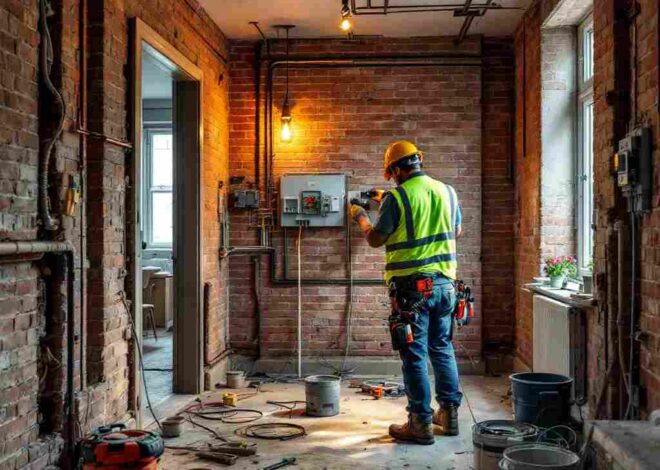
Should You Hire a Pro or Go DIY? Evaluating Exterior Home Painting Projects
When it comes to giving your home a fresh look, few things are as transformative as a new coat of paint. But before you dive headfirst into the world of brushes and rollers, it’s essential to weigh your options: should you enlist the help of a professional painter or tackle this project yourself?
Whether you’re dreaming of vibrant hues that pop against your landscape or simply want to rejuvenate your home’s curb appeal with classic neutrals, join us as we navigate the colorful decision-making process together! Let’s get painting (or not)!
Introduction to Exterior Home Painting Projects
Your home’s exterior is its first impression, and nothing enhances that look quite like a fresh coat of paint. Whether you’re aiming to boost curb appeal or protect your property from the elements, painting your home’s exterior can be a fulfilling project. But should you grab a brush and tackle it yourself, or enlist the help of professionals? It’s a debate many homeowners face when considering an exterior painting DIY project.
Choosing between going DIY or hiring experts involves weighing various factors—time, budget, skill level, and desired outcome. In this blog post, we’ll dive into the pros and cons of both approaches. By evaluating these points carefully, you can make an informed decision that will leave your home looking stunning for years to come. Let’s explore what each option brings to the table!
Understanding the Importance of Exterior Home Painting
Exterior home painting is more than just a cosmetic upgrade. It plays a vital role in protecting your property from the elements. Rain, sun, and wind can take a toll on your home’s exterior surfaces. A fresh coat of paint acts as a shield, preventing moisture intrusion and wood rot.
Moreover, it enhances curb appeal significantly. First impressions matter, especially for visitors or potential buyers. A well-painted home reflects care and attention to detail.
Color also influences mood and perception. Choosing the right hues can elevate your home’s aesthetic while complementing its architectural style.
Regular maintenance through painting helps preserve the value of your property too. Investing time and resources into exterior painting ensures that you maintain not only beauty but also structural integrity for years to come.
Pros and Cons of Hiring a Professional
Hiring a professional for exterior painting comes with distinct benefits. First, their expertise can lead to high-quality results. Professionals understand the nuances of paint application, ensuring even coverage and durability.
Another advantage is time efficiency. A pro can often complete the job faster than an inexperienced homeowner due to their skills and access to specialized equipment. This frees you up for other important tasks.
However, there are drawbacks as well. The cost of hiring someone can be significant, especially if you’re on a tight budget.
Additionally, scheduling may pose challenges; finding availability that aligns with your timeline could delay your project further. It’s essential to weigh these factors carefully before deciding what route suits your needs best.
-
Benefits of Hiring a Pro
Hiring a professional for exterior painting brings expertise to the table. Professionals have extensive experience and knowledge of various painting techniques. This ensures that your home receives a high-quality finish that lasts.
Another significant benefit is access to top-notch materials. Pros often have relationships with suppliers, allowing them to source premium paints and tools at better prices than most DIYers can find.
Moreover, professionals come equipped with the right gear and technology. They are prepared for any challenges, from ladders to scaffolding, ensuring safety during the project.
Time-saving is another advantage. While DIY projects can drag on due to inexperience or unexpected obstacles, pros work efficiently and complete tasks on schedule.
Lastly, hiring an expert provides peace of mind. Knowing your home is in capable hands allows you to focus on other priorities while enjoying stunning results without stress.
-
Drawbacks of Hiring a Pro
Hiring a professional for exterior painting can come with significant drawbacks. The most immediate concern is the cost. Professional services often charge premium rates, which may not fit every homeowner’s budget.
Additionally, there’s a lack of control over the process. Once you hand over the project to a contractor, you may find yourself relying heavily on their judgment regarding color choices and techniques.
Scheduling can also pose challenges. You might have to wait weeks or even months for availability, delaying your project’s timeline significantly.
Lastly, if you’re not careful in choosing a contractor, you risk inconsistency in quality. Not all professionals deliver top-notch results; poor workmanship could leave you regretting your decision down the line.
Pros and Cons of DIY Painting
DIY painting can be an exciting venture for those who love a hands-on approach. One major advantage is the cost savings. By skipping the professional fee, you keep more money in your pocket.
Flexibility also plays a key role. You set your own schedule and work at your pace, allowing creativity to flow without pressure.
However, DIY projects come with their challenges. Lack of experience can lead to mistakes that may require costly fixes later on.
Additionally, time investment should not be overlooked; preparing surfaces and waiting for paint to dry can stretch timelines longer than anticipated.
Lastly, achieving a professional finish requires skill and knowledge about techniques that might take years to master. With these factors in mind, weighing the pros and cons becomes essential before picking up that paintbrush.
-
Advantages of Doing it Yourself
One of the main advantages of doing it yourself in exterior painting is cost savings. You can skip the hefty labor fees associated with hiring a professional. Instead, you only pay for materials.
Another perk is complete control over the project. You get to choose colors, finishes, and techniques that reflect your personal style without any compromises.
DIY projects also allow for flexibility in scheduling. You can work at your own pace and tackle sections when it’s convenient for you—no need to coordinate with someone else’s schedule.
Lastly, there’s immense satisfaction in completing a project on your own. Each brushstroke becomes a testament to your effort and creativity. Plus, you’ll gain valuable skills along the way that could benefit future home improvement endeavors.
-
Disadvantages of DIY Painting
DIY painting can be enticing, but it carries its own set of challenges. One major drawback is the potential for poor results. Without professional experience, achieving an even coat and perfect finish can be difficult.
Time is another significant factor. Painting a home’s exterior is labor-intensive and time-consuming, especially if you have other responsibilities or commitments. It may take longer than anticipated to complete the job.
Safety concerns also come into play. Climbing ladders and working at heights poses risks that many DIYers might underestimate.
Moreover, there’s the issue of equipment costs. Quality tools and materials add up quickly, sometimes negating any savings from not hiring a pro.
Finally, weather conditions can thwart your plans unexpectedly, leading to delays or compromised quality if you’re not careful with timing.
Factors to Consider Before Deciding
When deciding whether to tackle exterior painting DIY or hire a professional, several key factors come into play.
Budget is often the first consideration. Assess your financial situation and determine how much you can comfortably spend on paint, supplies, and labor if necessary.
Time and availability are also critical. Do you have weekends free or enough evenings to dedicate? Painting takes time, especially for larger homes. If your schedule is packed, hiring a pro might be more feasible.
Lastly, think about your experience and skill level. A solid background in painting can make the DIY route successful. However, if you’re unsure of your skills or lack experience with tools and techniques, it may lead to costly mistakes that outweigh any savings.
-
Budget
Budget plays a crucial role in deciding between hiring a professional and tackling exterior painting DIY projects. Understanding your financial limits is the first step.
If you choose to hire a pro, costs can vary widely. You might pay more for quality service, but it often comes with peace of mind. Be prepared for estimates that include labor and materials.
On the other hand, going DIY may seem appealing initially due to lower expenses. However, consider hidden costs like tools and paint supplies that could add up quickly.
Factor in your willingness to invest time versus money. Sometimes spending on expertise saves you from costly mistakes later on.
Assess how much you’re truly ready to allocate before making any commitments. A clear budget helps streamline the decision-making process significantly.
-
Time and Availability
When considering exterior painting, time and availability are crucial factors. Painting your home is not just about the labor; it also requires ample hours for preparation and application.
If you have a busy schedule or family commitments, DIY may become overwhelming. Projects can extend longer than anticipated due to weather changes or unexpected repairs. This could lead to an unfinished look that affects curb appeal.
On the other hand, hiring a professional can alleviate this pressure. Pros often complete tasks more quickly thanks to their expertise and efficient methods. They manage schedules effectively, allowing you peace of mind while ensuring quality work.
Assessing how much time you realistically dedicate to painting helps clarify your choice between DIY and hiring someone else. Prioritize your availability so that your house looks its best without adding stress to your life.
-
Experience and Skill Level
Your experience and skill level play a crucial role in deciding whether to tackle an exterior painting project yourself or bring in a professional. If you’ve painted before, even on smaller projects, you might have the confidence to take this one on.
However, if you’re unfamiliar with the nuances of preparation and application techniques, consider the learning curve. Mistakes can lead to unsightly results or costly repairs down the line.
Assess your comfort with tools like sprayers, rollers, and brushes. A steady hand makes all the difference when achieving clean lines and even coverage.
Remember that weather conditions can impact your work as well; knowing how paint reacts under different circumstances is essential for success. Ultimately, be honest with yourself about what you excel at—this will guide your decision-making process effectively.
You may also read (cost of home improvement insurance)
Tips for Successful DIY Exterior Home Painting
Preparing the exterior surface is crucial. Start by cleaning off dirt, dust, and mildew. A pressure washer can work wonders here. Make sure to repair any cracks or damage beforehand.
Choosing the right tools makes a difference. Invest in quality brushes, rollers, and sprayers suited for outdoor use. This will ensure even application and durability.
Proper techniques are key for a flawless finish. Begin with primer to create an excellent base layer, especially if you’re making a significant color change. Apply paint in thin layers rather than thick ones for better adhesion.
Don’t forget about weather conditions! Avoid painting on windy days or when rain is forecasted within 24 hours after application.
Lastly, take your time. Rushing through this project often leads to mistakes that could have easily been avoided with patience and attention to detail.
-
Preparing the Exterior Surface
Preparing the exterior surface is a crucial step in any successful painting project. Start by inspecting the area for peeling paint, cracks, or mildew. Addressing these issues early can save you time and frustration later.
Next, clean the surface thoroughly. Use a power washer or a scrub brush with soap to remove dirt, grime, and old paint residues. This ensures that new paint adheres properly.
Once cleaned, allow everything to dry completely before proceeding. Moisture can lead to poor adhesion and bubbling after application.
Don’t forget about sanding! Smooth out rough areas and edges where necessary. This creates an even canvas for your fresh coat of paint.
Lastly, apply primer if needed—especially on bare wood or metal surfaces—to enhance durability and color vibrancy. Taking these steps will set you up for success when diving into your exterior painting DIY project.
-
Choosing the Right Tools and Materials
Choosing the right tools and materials is crucial for a successful exterior painting DIY project. Start with quality paint that suits your climate and surface type. Look for options specifically designed for exteriors to ensure durability.
Next, invest in good brushes and rollers. High-quality tools can make a noticeable difference in the finish of your work. A brush will help you navigate corners, while rollers cover large areas efficiently.
Don’t forget about primers! They create a smooth base, enhance color vibrancy, and extend the life of your paint job.
Also, consider protective gear like goggles and masks to keep yourself safe from fumes or dust particles during application.
Lastly, have all necessary supplies on hand before starting—drop cloths, painter’s tape, ladders—and ensure they are appropriate for outdoor use. This preparation helps avoid unnecessary interruptions once you’re ready to begin painting.
-
Proper Techniques for Paint Application
Proper paint application is crucial for achieving a smooth and durable finish. Start by using high-quality brushes or rollers that suit the type of paint you’re applying. A good brush can make all the difference.
Always begin at the top of your surface, working downwards to avoid drips. This method helps maintain an even coat while ensuring any excess paint flows downward rather than ruining already painted areas.
Apply thin layers instead of one thick coat. Multiple thin coats will dry more evenly and provide better coverage without runs or streaks.
Don’t forget about technique! Use long, even strokes when painting with a brush, and apply consistent pressure on your roller to avoid uneven patches.
Lastly, keep a wet edge as you work—this means overlapping wet paint with fresh applications so that everything blends seamlessly together for a professional appearance.
When to Hire a Pro vs. When to Go DIY
Deciding between hiring a professional and tackling exterior painting DIY depends on various factors. If your home’s exterior requires extensive prep work or repair, it may be best to call in the experts. They have the tools and skills to handle challenging surfaces, ensuring a high-quality finish.
On the other hand, if you’re comfortable with basic painting techniques and your project is manageable, going DIY could be rewarding. Painting small areas or refreshing an already well-maintained surface can easily fall within your skill set.
Consider how much time you can dedicate to this project. Professionals work efficiently under tight schedules but typically come at a higher cost. Conversely, if you enjoy hands-on projects and have ample free time, embracing DIY might provide both satisfaction and savings.
Evaluate safety concerns as well; high ladders or tricky angles are often safer in capable hands than on inexperienced shoulders.
Conclusion: Making the Best Decision for Your Home
When deciding whether to hire a professional or tackle exterior painting DIY, it’s essential to weigh your options carefully. Each approach has its unique set of advantages and challenges. Hiring experts can save time and guarantee quality. However, it comes at a cost that may not fit every budget.
On the other hand, embracing a DIY project can be fulfilling and economical but demands careful consideration of your skills and available resources. It’s about finding the right balance between your capabilities, time constraints, and financial situation.
Ultimately, understanding what is best for your home depends on these factors. Every house is different just like every homeowner’s preferences are unique. By reflecting on these aspects thoughtfully, you’ll arrive at a decision that enhances both the beauty of your home and your peace of mind.
You may also read (foundation maintenance 101 top home strategies)


